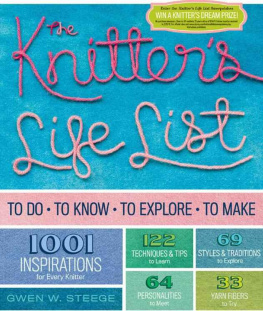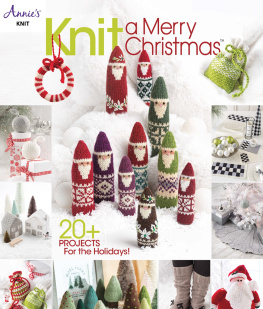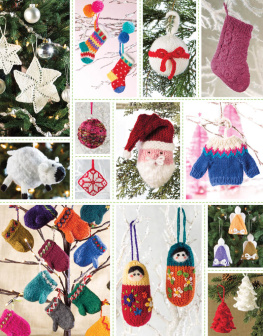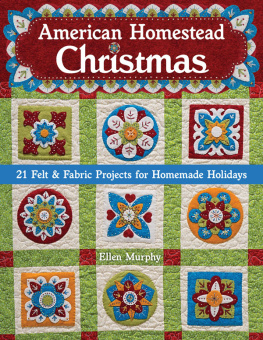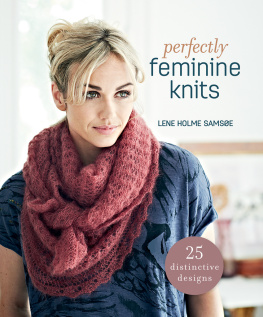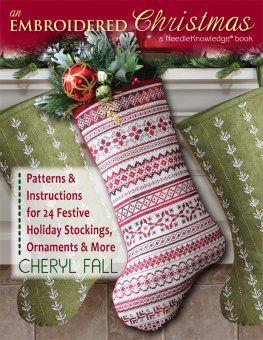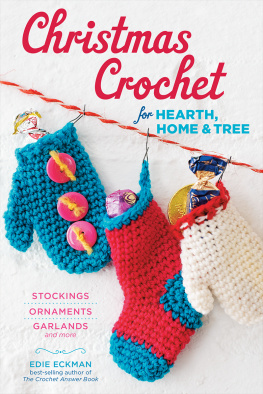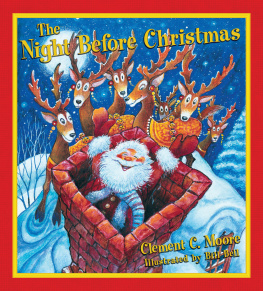101 Ebooks for Cooking, Crafting, and Gift-Making for $4.99 or Less
Weve cracked open our library to offer you a treasure trove of handpicked, foolproof instructions for projects like knitting your own Christmas stockings, making Brooklyns best artisanal candies in your home kitchen, and turning an ordinary bottle of liquor into a memorable flavored liqueur.
To learn more, visit HomemadeHoliday101.com .
Happy Homemade Holidays!
Contents
Stockings Up!
A hand-knit Christmas stocking is bound to be a treasure for years to come, whether you lovingly knit one as a gift or create a set for your own family. In the pages that follow, we offer a wide variety of styles, so youre sure to find one thats perfect for the spotlight it will claim in your home. Some of our patterns are as traditional as the holidays themselves, while others offer a new twist to classic ideas, with their bright and surprising color combinations. Youll find several felted knitting projects, multicolor patterns, and some interesting textural designs. Some of the stockings are extra large; in contrast, youll find mini socks, as well as miniature mittens and sweaters just right for hanging on the tree or even packaging small gifts. Everyone seems to want to knit socks these days, and knitting a roomy Christmas stocking is a wonderful way for novice knitters to learn some basic sock-knitting techniques. Plus, no second-sock syndrome: you have to knit only one! So choose a pattern from our collection of talented designers, pick up your needles and yarn, and get set to knit a true Christmas heirloom!

Anatomy of a Sock
Real socks must fit a three-dimensional foot and, for comforts sake, have few or no seams. Knitted from top to toe, in the round on circular or double-pointed needles, socks are shaped as you knit. Heres a brief rundown of the basic structure to help you envision your sock project as a whole.
Each stocking in this book starts at the top by knitting the cuff and then the leg. When you get to the ankle, you set aside the stitches across the top of the foot (the instep) on a spare needle or stitch holder and, for just this section, knit back and forth on straight needles to create a little rectangle called the heel flap. Next, you pick up stitches along both sides of the heel flap, retrieve the instep stitches, and again begin to knit circularly. To accommodate the wider shape of the foot at the ankle, the diameter of the sock is wider here than at the leg and along the length of the foot, so in order to narrow the stocking again to create the foot, you make a series of decreases at each side of the heel, forming the gusset. When the foot is the desired length, you shape the toe with further reductions. Close off the toe stitches, and your stocking is ready to hang!
Yarns to Yearn For
Todays yarn selection makes knitting more fun than its ever been before. The stockings in this book were knit with yarns of varied fiber content and weight. We tell you exactly which yarns the pictured stockings were knit with, but we hope that youll enjoy experimenting with your own color combinations and yarn varieties wool, cotton, synthetics, and blends, and maybe even luxury fibers. After all, a very special stocking may someday become a family heirloom. The choice is yours, as long as you keep in mind that you must get the gauge indicated by the pattern (see , below).
Be sure to buy enough yarn to complete your project. Youll find information about the number of skeins needed for each pattern in this book, along with the weight and yardage of the skeins we used. If you substitute, be sure to compare your yarns yardage to the pattern requirement. Yardage is usually listed on the label; if not, ask your yarn shop to check the manufacturers specifications. Its always a good idea to buy an extra skein to avoid running short; most yarn shops accept returns of untouched skeins of yarn as long as you do so within a reasonable length of time. Check your shops return policy.
Short Talk
If youre new to knitting, abbreviations can seem like a foreign language, so in this book weve avoided overusing them as much as possible. Heres what youll find:
CC - contrasting color
K - knit
K2tog - knit 2 stitches together
M1 - make 1 stitch
MC - main color
P - purl
P2tog - purl 2 stitches together
psso - pass slipped stitch over
ssk - slip, slip, knit the two slipped stitches together
yo - yarn over
Yarns for Felting
Any animal fiber, such as wool, alpaca, and mohair, will felt, as long as it hasnt been pretreated. Washable (superwash) wool, bleached white wool, cotton, rayon, silk, and synthetic fibers dont felt. Many off-white and light colors do not felt well, if at all. Its not unusual to find that different colors of the same yarn felt differently. Some yarns require a longer period of agitation than others, or they may not ever achieve the degree of felting desired. Making swatches is always a good idea, but before jumping into any felted knitting project, its especially important to knit and felt a swatch with the yarns youve chosen. (For more about felting, see .)
Getting Equipped
Most knitters have strong preferences when it comes to selecting knitting needles, and the wide variety of choices can be confusing until you try them. Coated aluminum needles are durable but sometimes heavy in larger sizes. I find that slippery yarns tend to slide rather easily off metal needles. Plastic or similar materials are lighter, though they can bend or break, and yarn sometimes sticks to them. Depending on the yarn youre working with, bamboo or wood needles may be a good compromise. The yarn moves smoothly along them, even in hot, sticky weather, and theyre quiet and comfortable to use.
Most of the patterns in this book are knit on double-pointed or circular needles. Available in several lengths, circular needles have a flexible nylon or plastic center cable. Double-pointed needles come in sets of four or five. If youve always used four for knitting in the round, youll find knitting with five is easier and less likely to leave telltale lines (known as ladders) between the needles.
The size of knitting needles is indicated by number. Its important to note whether the size is US, UK, or metric theyre all different! The chart on gives equivalent sizes for all three. Youll note that in the US system 0 is very small, whereas in the UK system 0 is large. This book provides US and metric (but not UK) sizes in all the instructions.
Do Bag It!
Although you can get started on most projects with little more than yarn and needles, a nice, well-supplied knitting bag, like all tool kits, makes life easier. Here are some suggestions for things you might need:


